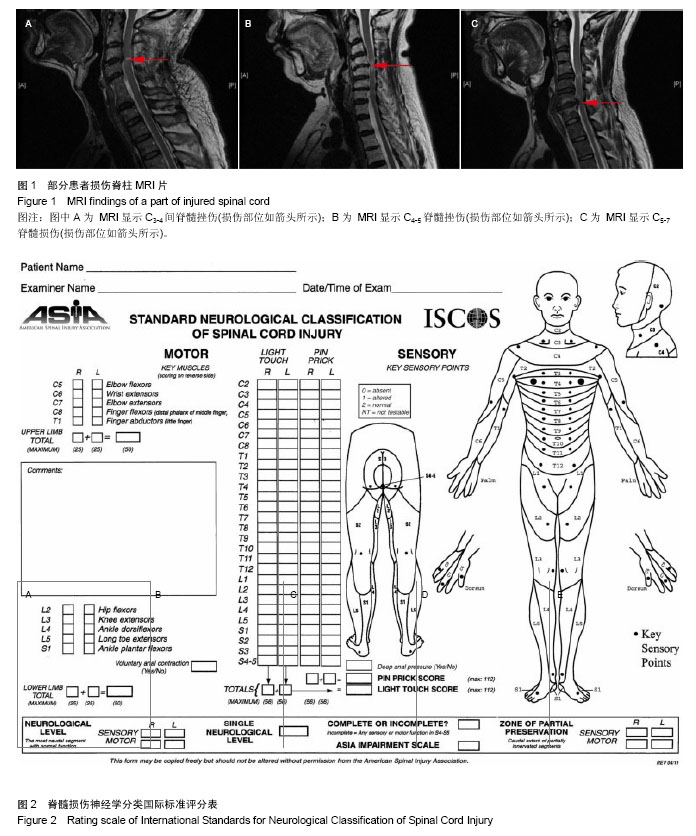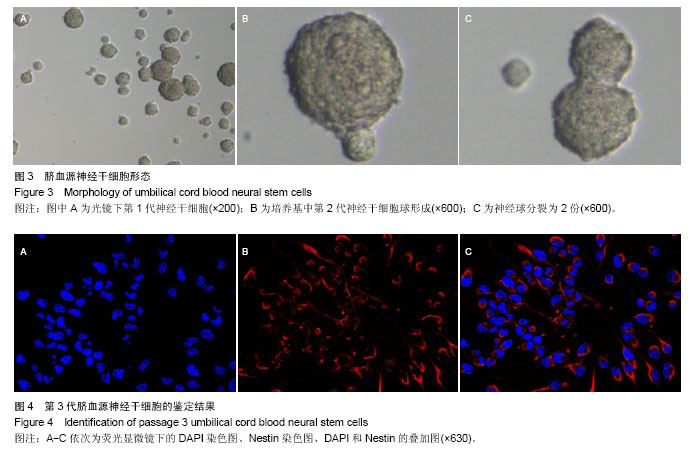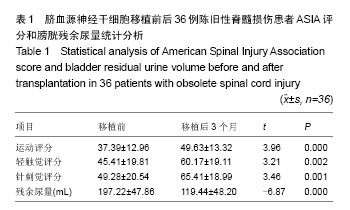| [1] Cristante AF, Barros Filho TE, Marcon RM,et al.Therapeutic approaches for spinal cord injury.Clinics (Sao Paulo). 2012; 67(10):1219-1224.
[2] 吴月奎,王尚武,戴宜武,等.脊髓损伤的干细胞治疗研究进展[J].中华神经医学杂志,2014,13(7):753-755.
[3] Park DH, Lee JH, Borlongan CV,et al.Transplantation of umbilical cord blood stem cells for treating spinal cord injury. Stem Cell Rev. 2011;7(1):181-194.
[4] Hollis ER 2nd, Tuszynski MH.Neurotrophins: potential therapeutic tools for the treatment of spinal cord injury.Neurotherapeutics. 2011;8(4):694-703.
[5] Batista CE, Mariano ED, Marie SK, et al.Stem cells in neurology--current perspectives.Arq Neuropsiquiatr. 2014; 72(6):457-465.
[6] Cui B, Li E, Yang B,et al.Human umbilical cord blood-derived mesenchymal stem cell transplantation for the treatment of spinal cord injury.Exp Ther Med. 2014;7(5):1233-1236.
[7] Dasari VR, Veeravalli KK, Dinh DH.Mesenchymal stem cells in the treatment of spinal cord injuries: A review.World J Stem Cells. 2014;6(2):120-133.
[8] Zheng ZC,Liu GF, Chen YX,et al.Olfactory ensheathing cell transplantation improves sympathetic skin responses in chronic spinal cord injury. Neural Regen Res.2013; 8(30): 2849-2855.
[9] 9 Yao LQ,He C, Zhao Y,et al. Human umbilical cord blood stem cell transplantation for the treatment of chronic spinal cord injury. Neural Regen Res.2013;8(5): 397-403.
[10] Hu SL, Luo HS, Li JT,et al.Functional recovery in acute traumatic spinal cord injury after transplantation of human umbilical cord mesenchymal stem cells.Crit Care Med. 2010; 38(11):2181-2189.
[11] Kang KS, Kim SW, Oh YH,et al.A 37-year-old spinal cord-injured female patient, transplanted of multipotent stem cells from human UC blood, with improved sensory perception and mobility, both functionally and morphologically: a case study.Cytotherapy. 2005;7(4):368-373.
[12] Lee MW, Choi J, Yang MS,et al.Mesenchymal stem cells from cryopreserved human umbilical cord blood.Biochem Biophys Res Commun. 2004;320(1):273-278.
[13] Ozdemir M, Attar A, Kuzu I,et al.Stem cell therapy in spinal cord injury: in vivo and postmortem tracking of bone marrow mononuclear or mesenchymal stem cells.Stem Cell Rev. 2012; 8(3):953-962.
[14] Furlan JC, Fehlings MG, Tator CH,et al.Motor and sensory assessment of patients in clinical trials for pharmacological therapy of acute spinal cord injury: psychometric properties of the ASIA Standards.J Neurotrauma. 2008;25(11):1273-1301.
[15] Vavra-Hadziahmetovi N, Mufti M.Determination of residual urine volume using a portable ultrasound apparatus in a rehabilitation center for spinal lesions.Med Arh. 2003;57(3): 165-167.
[16] Buzańska L, Jurga M, Stachowiak EK,et al.Neural stem-like cell line derived from a nonhematopoietic population of human umbilical cord blood.Stem Cells Dev. 2006;15(3): 391-406.
[17] Ali H, Bahbahani H.Umbilical cord blood stem cells - potential therapeutic tool for neural injuries and disorders.Acta Neurobiol Exp (Wars). 2010;70(3):316-324.
[18] Arien-Zakay H, Lecht S, Nagler A,et al.Human umbilical cord blood stem cells: rational for use as a neuroprotectant in ischemic brain disease.Int J Mol Sci. 2010;11(9):3513-3528.
[19] Lee MW, Jang IK, Yoo KH, et al.Stem and progenitor cells in human umbilical cord blood.Int J Hematol. 2010;92(1):45-51.
[20] Jaing TH.Umbilical cord blood: a trustworthy source of multipotent stem cells for regenerative medicine.Cell Transplant. 2014;23(4-5):493-496.
[21] Zhong XY, Zhang B, Asadollahi R, et al.Umbilical cord blood stem cells: what to expect.Ann N Y Acad Sci. 2010;1205: 17-22.
[22] Zhang HT, Yang HL, Zhan HX,et al. Functional recovery and microenvironmental alterations in a rat model of spinal cord injury following human umbilical cord blood-derived mesenchymal stem cells transplantation. Neural Regen Res. 2010;5(3):165-170.
[23] Zhao T, Li Y, Tang L,et al.Protective effects of human umbilical cord blood stem cell intravitreal transplantation against optic nerve injury in rats.Graefes Arch Clin Exp Ophthalmol. 2011; 249(7):1021-1028.
[24] Elkelini MS, Bagli DJ, Fehlings M,et al.Effects of intravesical onabotulinumtoxinA on bladder dysfunction and autonomic dysreflexia after spinal cord injury: role of nerve growth factor. BJU Int. 2012;109(3):402-407.
[25] Li C, Zhang X, Cao R,et al.Allografts of the acellular sciatic nerve and brain-derived neurotrophic factor repair spinal cord injury in adult rats.PLoS One. 2012;7(8):e42813.
[26] Lee JH, Chung WH, Kang EH,et al.Schwann cell-like remyelination following transplantation of human umbilical cord blood (hUCB)-derived mesenchymal stem cells in dogs with acute spinal cord injury.J Neurol Sci. 2011;300(1-2): 86-96.
[27] Busch SA, Horn KP, Cuascut FX,et al.Adult NG2+ cells are permissive to neurite outgrowth and stabilize sensory axons during macrophage-induced axonal dieback after spinal cord injury.J Neurosci. 2010;30(1):255-265.
[28] Dasari VR, Spomar DG, Li L,et al.Umbilical cord blood stem cell mediated downregulation of fas improves functional recovery of rats after spinal cord injury.Neurochem Res. 2008; 33(1):134-149.
[29] Veeravalli KK, Dasari VR, Tsung AJ,et al.Human umbilical cord blood stem cells upregulate matrix metalloproteinase-2 in rats after spinal cord injury.Neurobiol Dis. 2009;36(1): 200-212.
[30] Dasari VR, Veeravalli KK, Tsung AJ,et al.Neuronal apoptosis is inhibited by cord blood stem cells after spinal cord injury.J Neurotrauma. 2009;26(11):2057-2069.
[31] Park SI, Lim JY, Jeong CH,et al. Human umbilical cord blood-derived mesenchymal stem cell therapy promotes functional recovery of contused rat spinal cord through enhancement of endogenous cell proliferation and oligogenesis.J Biomed Biotechnol. 2012;2012:362473.
[32] van der Meulen AA, Biber K, Lukovac S,et al.The role of CXC chemokine ligand (CXCL)12-CXC chemokine receptor (CXCR)4 signalling in the migration of neural stem cells towards a brain tumour.Neuropathol Appl Neurobiol. 2009; 35(6):579-591.
[33] Forostyak S, Jendelova P, Sykova E.The role of mesenchymal stromal cells in spinal cord injury, regenerative medicine and possible clinical applications.Biochimie. 2013; 95(12):2257-2270. |


